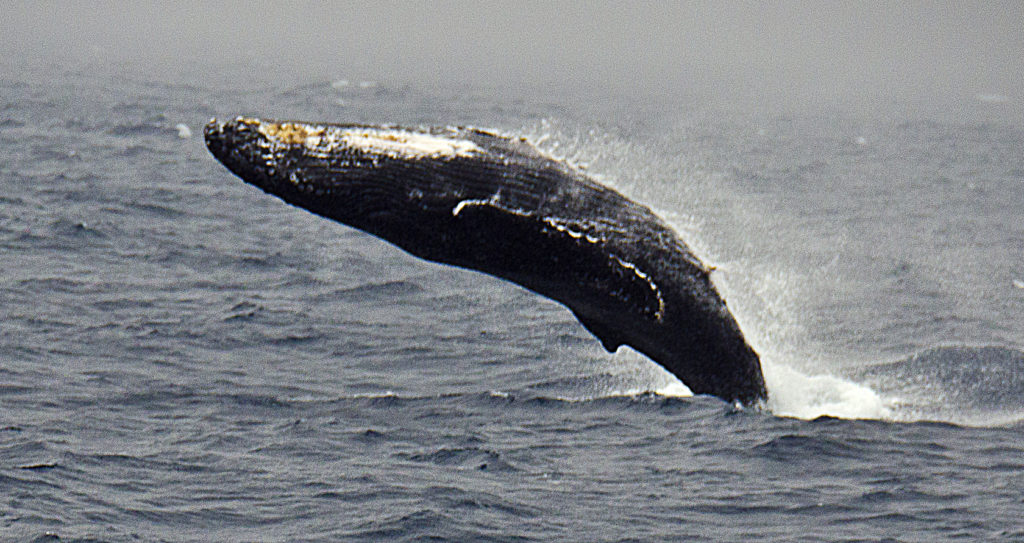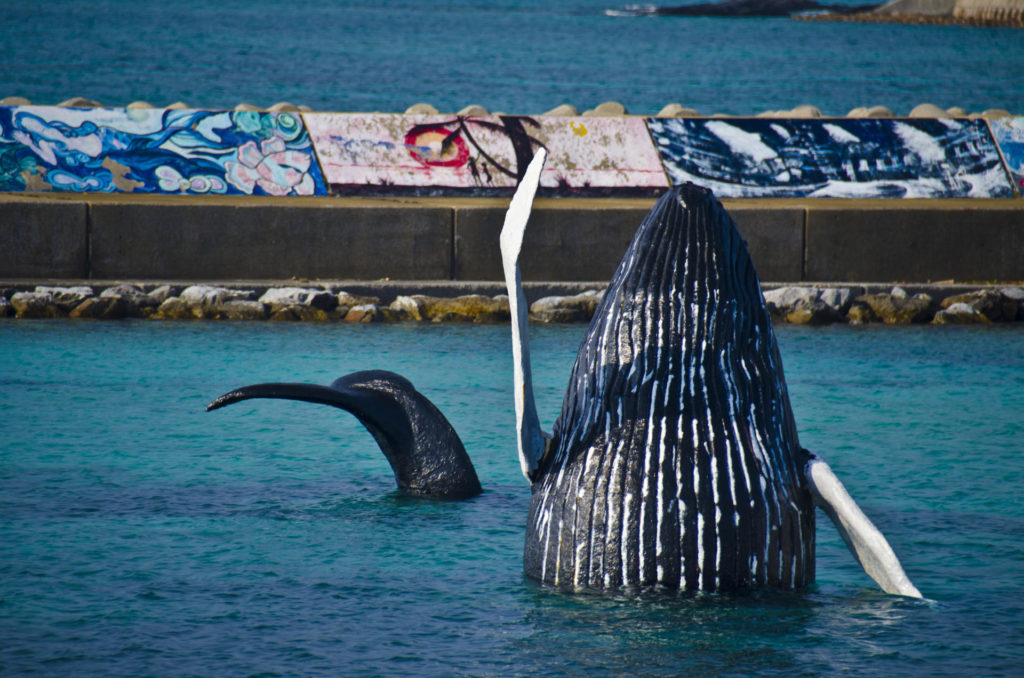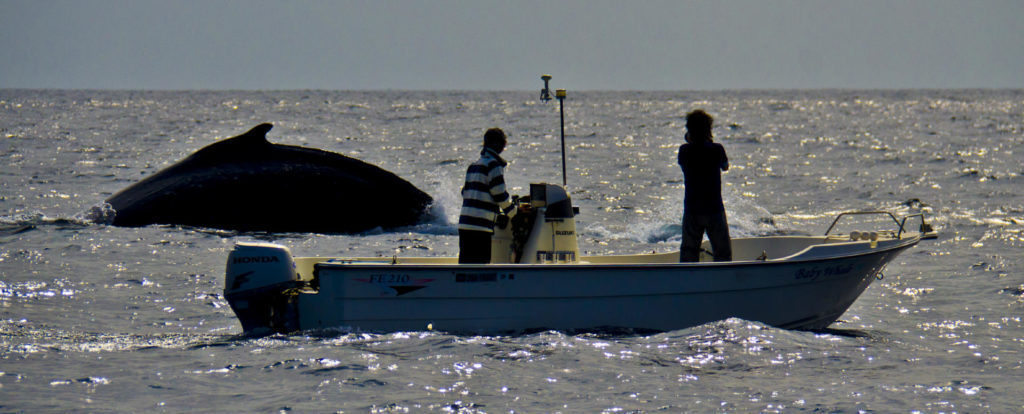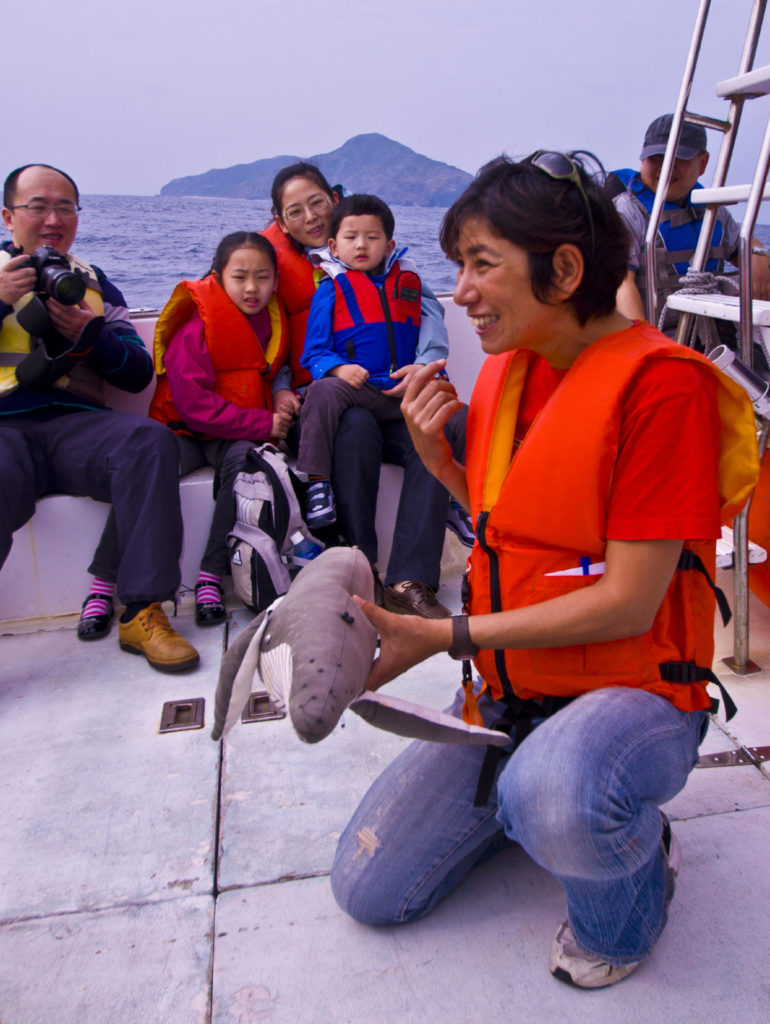There was a time, several decades ago, when the humpback whales stopped coming to Okinawa. Today, hundreds return each winter, and whale watching attracts throngs of visitors who come to Okinawa Island and Zamami to see these giants of the ocean in the wild.

The Okinawa Islands are part of the larger Ryukyu island chain, which stretches from Kyushu all the way to Taiwan. Okinawa Island is the most populated; home to more than a million people, many of whom live in the capital, Naha.
From spring to autumn, Okinawa is a tropical paradise, a place to unwind and enjoy warm weather, beautiful beaches, scuba diving and marine sports.
Winter is a relatively quiet time to visit; yet over the past two decades whale watching tourism has grown significantly. About 500 humpback whales breed in waters around the Okinawa and Ogasawara Islands (also known as the Bonin Islands), a marine preserve 25 hours east of Tokyo by ship.
It’s reasonable to think more remote islands, such as Ogasawara, would be the natural place to find whales. Although humpbacks frequent these waters, they don’t seem to care much about what’s happening on land.
Like the waters around Oahu, another island with a population of more than a million, the whales can be found a short boat ride away from Okinawa Island and Naha.

The whales instinctively return to their natural breeding grounds to birth and mate, as they have for thousands of years. The males fight over females in spectacular shows of testosterone, called heat runs, and the females protect their calves, eventually taking on an escort male to keep suitors away and to accompany them on the journey back to summer feeding grounds.
They are long distance travelers. From spring to autumn, they travel the 3,200 miles to Russia’s Kamchatka Peninsula and around the Attu and Kiska Islands to feed in the plankton-rich waters there.
Every year between January and April, hundreds of humpback whales migrate back to Okinawa. After being hunted to the brink of extinction, humpbacks have been spotted around Okinawa’s main island since the mid 1980s.
The Easy Way Out
As we finished our coffee, the van rolled up to our Naha hotel. Minutes later, we were at the dockside office of Marine House Seasir filling out a bit of paperwork. I walked across the street to the boat chatting with one of the friendly guides. Originally from Osaka, she said there’s nothing she loves more than going out to see whales, rain or shine.
Two Seasir boats were docked and ready. Both spacious with open decks and enclosed cabins. My fellow passengers hailed from Taiwan, Japan, the U.S. and Europe and all walks of life. Ages ranged from young children to adults in their late 60s. We received a thorough briefing from the crew on whale behavior and how to spot the whales by recognizing the crew’s hand signals.
As we ventured out of the harbor and into the open sea, we headed north up the coast of the main island. After no sightings, we went in the direction of Ie-shima off the Motobu Peninsula. This is when the excitement started.
On this wavy day, the distant breaches could easily have been mistaken for whitecaps. But the keen eyes of the crew spotted something. We soon see a huge geyser of ocean spray in the distance as a drizzle of cool rain begins to fall. The incoming storm doesn’t sway the determined captain of the Seasir who speeds toward the action. As we approach, we could see we were in for a real treat. One breach, then another followed by a huge splash.

We come in close and people scramble to the ship’s upper deck for a better view. The humpback whales were enjoying the choppy seas and rainy weather. It’s a female with her calf, which appears to have been born early this season. She’s teaching her baby to breach.
During these lessons, the whales launch their huge bodies completely out of the water. We had front row seats to this amazing show as they played unfazed by our presence.
The mother would swim on her side, lie on her back and clap her huge pectorals together above the water. There were plenty of tail slaps and the baby would sneak some looks at us above the water, but he really seemed to be enjoying learning to breach.
Despite wet and windy conditions, we witnessed some great humpback displays. The trip was not without its casualties, and the friendly crew helped a few with seasickness. Once tucked into the lee of the Okinawan mainland again, most people began to feel better and reveled in the spectacle they had just witnessed.

Zamami Whale Spotters
Twenty miles (32 km.) southwest of Okinawa Island, you’ll run into a chain of subtropical islands called the Keramas. Although they are easily accessible by sea or air, they remain idyllic. Only four of the Kerama 22 islands are inhabited: Aka, Geruma, Tokashiki and Zamami.
Zamami is a whale-watching center about an hour from Naha’s Tomari Port. A comfortable, albeit slightly pricey, high-speed ferry leaves each day at 9 a.m. It’s easy to do a day trip to Zamami, so we decided to go and have a look around the island.
As we neared Zamami, we spotted Aka-jima and Geruma-jima, two islands connected by Aka-ohashi Bridge. A small airport was visible on Geruma Island. Off in the distance there are undeveloped islands with primeval forests where the protected species of Kerama deer live.
As you enter the Zamami Harbor, a statue of a breaching whale protrudes from the sapphire sea. In a park nearby the island’s school kids covered a wall with paintings of whales. We were clearly in the right place.
The sea that surrounds the Keramas is supplied from the Kuroshio Current feeding healthy coral reefs and creating a rich diversity of sea life. In winter, it’s all about the whales but, in the warmer months, this is a great place for diving, snorkeling, fishing and sea kayaking.
Above the sea, well-marked hiking trails lead to lush, green hills and unspoiled beaches where sea turtles lay their eggs in sandy nests. A trail heads straight up from the village to a scenic park and the Mt. Takatsuki Observatory. The viewpoint overlooks Agonoura Bay, taking in the turquoise coral reefs, sandy beaches and tucked-away pearl farms.
This picturesque stretch of land forms the island’s northwestern peninsula, while nearby Inazaki Observatory looks out across the rocky northern coast. In all, there are nine such well-placed observatories where spotters, employed by the Zamami Whale Watching Association, spend the day perched with binoculars. Boat captains are radioed coordinates, allowing for a careful, low-speed approach to the whales.
During our recon trip, it was good fortune to run into the effervescent Momo Mikawa, the head whale guide for Heart Land Marine Shop. She explained how they created their own whale identification system using the whale’s signature tails.

They update their blog daily and have published a book about Kerama’s whales. Momo’s English is excellent, and it was fascinating to hear about what Heart Land had compiled over the years.
“In the early ’80s, the whales stopped coming here,” Momo said. “Then, in 1985, two whales showed up. Each year after it was a couple more. We have identified so many; there could be over 300, or more now.”
Under the guidance of the Zamami Whale Watching Association, self-imposed whale watching rules have been implemented to help ensure the sea around Okinawa will continue to be a breeding place for humpback whales. So far, this group of northern humpbacks has been quite the success story.
The next day the weather looked better, so we headed out. Momo was waiting for us at the dock and in minutes our small group, hailing from Japan, Vietnam, Taiwan and Guam, was on board.
As the boat left the harbor, we passed by a sandy spit that melted into the sea in an array of oscillating cobalt, mint blue and indigo. This is a big marine preserve and is a prized scuba destination.
Momo gave a briefing as we passed Unaji-no-sachi Point and into the open sea. We went north of Zamami into the area we had surveyed from the Inazaki outpost the day before.
“The bottom here is maybe 100 meters deep,” Momo said. “But it has sea mounts that come up to 40 meters. The whales like this area.” She adds that it drops off into an abyss farther west and bigger whales, such as sperm whales, have been seen there.
The beauty of the spotter program is that there isn’t a lot of time wasted searching for humpbacks. The boats already know where the whales are that morning after receiving intel. Humpbacks rarely dive for more than 20 minutes so, when one does, the guide and captain do their best to predict where it will surface.
Humpbacks are shy but curious. When one sees a boatload of whale watchers, it often stops to have a look or at least slows down. So even though boats try to maintain a certain distance out of respect for the whales, the whales may come right up to the boat anyway. That’s what happened to us.
There were three or four pairs surfaced as we looked on; they drew long breaths and then sounded again. No big breaches or amazing aquabatics, but a sunny and enjoyable morning.
I took a stroll into town to grab a bite and, as I made my way back to the pier, I passed a few traditional homes made of weathered wood and red tile roofs. Often a guardian shisa was placed on the rooftop and hinpun (walls) surrounding them. This was a traditional way to ward off evil. Other buildings were more modern, giving the village an eclectic charm.
We had time for one more trip out before heading back on the afternoon ferry. The wind died down, and we came across some curious whales. There were fewer boats out, and our whales were feeling braver.
Much to our delight, they stayed near our ship, floating in the water for long stretches. My guess is they were two “teenagers,” probably a couple of young males hanging out together. When they went directly under our boat you could see the white of their pectorals in the translucent blue water.
With Momo acting as head whale cheerleader, the group applauded the whales’ performance until it was time to head back. We shared a quick drink and admired each other’s photos.
If you are a serious whale photographer, the Whale Watching Association can arrange private boat charters in smaller boats with experienced whale captains. Snorkeling with the whales is not allowed, and there are only a few places in the world where it is.
From the deck of the Zamami Queen we waved long good-byes, saying farewell to Zamami Island. Whether you’re a veteran whale watcher or have never experienced the thrill of whale watching, this is a great place to see the largest creatures on earth up close and personal.

ESSENTIAL INFO
Getting There & Around: There are numerous daily flights to Naha from Tokyo and other major Japanese cities. It also hosts a number of international flights. Daily flights and ferries serve the Kerama Islands from Naha.
Accommodation: Everything from five-star hotels to hostels is available in Naha. Zamami has a nice selection of small hotels and pensions and camping is available at Ama Beach.
Naha Whale Watching: Whale watching boats go out every day from mid-January to March. You can expect to see whales 80 percent of the time. Bring binoculars or a camera with a good zoom lens and image stabilization. Seasir runs daily tours leaving at 9 a.m. and 1:30 p.m. Tours are roughly three hours long.
Marine House Seasir – Naha Branch
Tel: 090-8668-6544 (English)
E-mail: english@seasir.com
Zamami Whale Watching: For travelers with more time, a trip to Zamami Island is an opportunity to tour one of Okinawa’s outlying islands while enjoying whale watching at a more leisurely pace. Zamami also offers land-based conservatories for whale watching; a great venue for those who suffer from seasickness.
Ferries for Zamami leave regularly from Tomari Port’s South Pier in Naha. Ferry travel from Okinawa Island to Zamami takes 90-120 minutes. A high-speed ferry (Zamami Queen) takes 50-70 minutes.
The Zamami Whale Watching Association offers tours starting at the end of December to the beginning of April. Daily tours are two-and-a-half hours long, leaving at 10:30 a.m. and 1 p.m. from Zamami Port. Zamami has a Whale Watching Festival the last weekend of March.
Marine Shop Heartland
Tel: 098-987-2978




